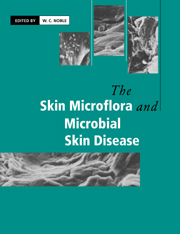Book contents
- Frontmatter
- Contents
- List of contributors
- Preface
- 1 The basis of the skin surface ecosystem
- 2 Nutrition of cutaneous resident microorganisms
- 3 Physical factors affecting the skin flora and skin disease
- 4 Coryneform bacteria
- 5 Coryneforms as pathogens
- 6 Staphylococci on the skin
- 7 Staphylococci as pathogens
- 8 Streptococci and the skin
- 9 Other cutaneous bacteria
- 10 Fungi and fungal infections of the skin
- 11 Bacterial and fungal skin disease in animals
- 12 Viral skin disease in man
- 13 Viral skin disease in animals
- 14 Microbial interactions on skin
- 15 Adherence of skin microorganisms and the development of skin flora from birth
- 16 Skin disinfection
- Index
9 - Other cutaneous bacteria
Published online by Cambridge University Press: 04 December 2009
- Frontmatter
- Contents
- List of contributors
- Preface
- 1 The basis of the skin surface ecosystem
- 2 Nutrition of cutaneous resident microorganisms
- 3 Physical factors affecting the skin flora and skin disease
- 4 Coryneform bacteria
- 5 Coryneforms as pathogens
- 6 Staphylococci on the skin
- 7 Staphylococci as pathogens
- 8 Streptococci and the skin
- 9 Other cutaneous bacteria
- 10 Fungi and fungal infections of the skin
- 11 Bacterial and fungal skin disease in animals
- 12 Viral skin disease in man
- 13 Viral skin disease in animals
- 14 Microbial interactions on skin
- 15 Adherence of skin microorganisms and the development of skin flora from birth
- 16 Skin disinfection
- Index
Summary
Apart from Acinetobacter spp. and Micrococcus spp., few bacteria other than coryneforms and staphylococci are found resident on skin. In this chapter are described the Gram-negative and Gram-positive bacteria regularly found on skin, together with those that contribute to well-recognized skin infection.
Gram-negative bacteria
Gram-negative bacilli are comparatively rare on normal skin, except for acinetobacter, which forms part of the normal flora in about a quarter of the population. Proteus is found on the nasal mucosa of about 5 per cent of individuals and both proteus and pseudomonas are found on the toe webs. The hands may also be temporarily colonized by a variety of bacilli. Apart from these sites the general skin surface of normal persons is sparsely colonized (Table 9.1) and the majority of organisms are probably transients or contaminants.
Acinetobacter spp.
Acinetobacter is the only genus of Gram-negative bacilli regularly found as a member of the skin flora in a significant number of individuals. About 25 per cent of normal adults carry acinetobacter in the axillae, groin, toe webs and antecubital fossa. In patients with eczema the carrier rate may be higher, especially on lesions, whilst in hospitalized patients with renal disease the carrier rate may exceed 50 per cent. Carriage of acinetobacter is more common in the summer months, probably due to increased sweating, and this is reflected in a pronounced summer maximum of endemic surgical wound infection, especially in young adults.
- Type
- Chapter
- Information
- The Skin Microflora and Microbial Skin Disease , pp. 210 - 231Publisher: Cambridge University PressPrint publication year: 1993
- 4
- Cited by



